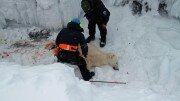Three years ago, scientists at the cultural heritage site at Russekeila on Cape Linné in Svalbard discovered – as they labeled it at the time – an unknown “grave.” Further research has revealed new details related to the discovery.
In 2019, within the framework of the multidisciplinary research project CULTCOAST, work at the cultural heritage site at Russekeila on Cape Linné in Svalbard uncovered what seemed to be an unknown grave at the water’s edge.
At the time, researchers believed the grave could date to the 16-1700s.
“In the grave, we see extremely fine knitted textile residues, woven textiles, wood scraps, and metal. Based on this, we believe that this can date from the 16-1700s,” archaeologist and head of the research project Vibeke Vandrup Martens from the Norwegian Institute of Cultural Heritage Research (NIKU) said in 2019.
However, further research has established that the find was not a grave but a refuse deposit from a later Norwegian hunting cabin from approximately 1850-1900.
New information
In an email to The Viking Herald, Vandrup Martens explained that a follow-up investigation by the archaeologist at the Governor of Svalbard, Lise Loktu, revealed new details.
“We (the CULTCOAST project) defined the archaeological remains as a likely grave during fieldwork in 2019 because of an exposed deposit stretching approximately 2 meters in length from east to west, containing fragments of wood, woven and knitted textiles, and iron nails. It was defined as unknown, and possibly early, because it was on the western side of the river mouth and thus separated from the main burial site at Russekeila, the Russian hunting station dated to approximately 1700-1859, which is situated at the eastern side of the mouth of the Linné River at the western end of the Ice Fiord south coast.
“The remains were washed out/eroded further in 2020, which ensured an investigation by the archaeologist at the Governor of Svalbard, Lise Loktu.
Deposit from a hunting cabin
“During her work, she exposed and documented a 5-meter long section of what turned out NOT to be a grave, but a refuse deposit from the later Norwegian hunting cabin from approximately 1850-1900 (also placed on the western side of the river). The deposit contained datable ammunition shells, textile, wood, and animal bones.
“The deposit will be washed out further, but there is no risk of exposure of human remains here, simply a refuse deposit from the late 19th-century hunting cabin.
“This demonstrates the extremely active coastline, as it was buried beneath more than 50 centimeters of beach deposits during a period of approximately 100 years. That is a surprising result of the CULTCOAST project but alerts us all to the risks of losing information on sites because of rapid coastal transformations.
“The speed of these transformations is accelerated by climate change because the deposits are now mostly not frozen (loss of permafrost) and because the waters are open for longer periods of the year (loss of fiord ice),” Vandrup Martens told The Viking Herald.
CULTCOAST – project information
The goal of the CULTCOAST project is to find the best methods for monitoring, managing, and preserving coastal cultural heritage sites that are exposed to threats in the form of climate change and developmental pressures.
The researchers map, monitor, and collect data from selected sites – both above and below the ground – on Svalbard and in Andøya.
The project is led by the NIKU, with participants from NGU, SINTEF Community, USN, and St. Andrews University in the UK.
Source: The Viking Herald / #Norway Today / #NorwayTodayTravel
Do you have a news tip for Norway Today? We want to hear it. Get in touch at [email protected]






Be the first to comment on "What was believed to be an unknown centuries-old grave in Svalbard ends up being something completely different"